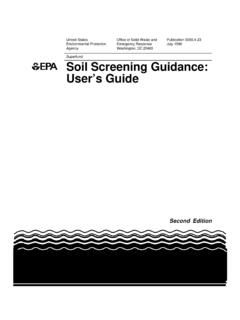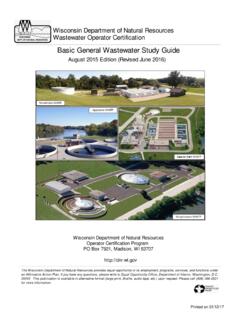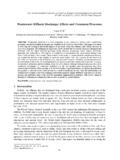Transcription of New York City’s Wastewater Treatment System
1 New York City Department of Environmental ProtectionMichael R. Bloomberg, MayorEmily Lloyd, CommissionerNew York City s Wastewater Treatment SystemCleaning the Water We Use Protecting the Environment We Live InNYCDEP .. New York City Department of Environmental ProtectionNYSDEC .. New York State Department of Environmental ConservationNYCDOS .. New York City Department of SanitationUSEPA .. United States Environmental Protection AgencyNYPA .. New York Power AuthorityNYCSWCD .. New York City Soil and Water Conservation DistrictALS .. American Littoral SocietyWPCP .. Water Pollution Control PlantNYOFCo .. New York Organic Fertilizer CompanyIPP .. Industrial Pretreatment ProgramPERC .. PerchloroethyleneCSO .. Combined Sewer OverflowEBPP .. Enhanced Beach Protection ProgramMGD .. Million Gallons per DayCWA .. Clean Water ActPCB .. Polychlorinated BiphenolsPAHs .. Poly-Aromatic HydrocarbonsBOD .. Biochemical Oxygen DemandTSS.
2 Total Suspended SolidsDO .. Dissolved OxygenBNR .. Biological Nutrient RemovalNew York City s Wastewater Treatment System1 List of AcronymsHow Water Gets to Us .. 4 History of New York City Water .. 4 Wastewater Treatment Past and Present .. 5-6 Nitrogen Control Applied Research Program .. 6 Wastewater Treatment Process .. 7-9 Preliminary TreatmentPrimary TreatmentSecondary TreatmentDisinfectionSludge TreatmentThickeningDigestionSludge DewateringBeneficial Use of Biosolids .. 9 How Biosolids Are Used .. 10-11 Land ApplicationCompostingAlkaline TreatmentHeat DryingHow New York City Protects Its Water Environment .. 11 Testing New York City WaterwaysEnvironmental Concerns .. 11 Toxic SubstancesPollution Control Programs .. 12-16 Industrial Pretreatment Program (IPP)Persistent Pollutant Track-down Program Perchloroethylene Program (PERC)Corrosion Control Program2 New York City s Wastewater Treatment SystemTable of ContentsPollution Control Programs Continued.
3 12-16 Pollution Prevention ProgramDry Weather DischargesGreasePumping Station TelemetryCombined Sewer OverflowsFloating DebrisWater Quality MonitoringRegulatory Telemetry System / Enhanced Beach Protection ProgramNutrientsWater WasteMap of New York Harbor and Historical Sampling Sites .. 15 Diagram of Treatment Process .. 16-17 How You Can Make a Difference .. 18-19 Conserve WaterKeep Hazardous Substance out of the Sewer SystemDon t LitterUse Mass TransportationDispose of Household Grease ProperlyVolunteer for Shoreline Cleanup and Survey ProgramsReport Dry Weather DischargesMap of New York City Plant Locations and Capacities .. 20 New York City Wastewater Treatment plants .. 21-24 DEP Sludge Vessels .. 25 Wastewater Treatment plants Before Modernization .. 26-30 Bureau of Wastewater Treatment Organizational Chart .. 31 How to Get in Touch with DEP ..32 New York City s Wastewater Treatment System34 New York City s Wastewater Treatment SystemHistory of New York City WaterWhere does New York City s water come from?
4 Each day New York City delivers about billion gallonsof safe drinking water to over 8 million City residents andanother 1 million consumers who live in Westchester,Putnam, Ulster and Orange Counties north of the source of New York City s drinking water is suppliedby a network of 19 reservoirs and three controlled lakes ina 1,972 square-mile watershed that extends 125 milesnorth and west of New York the water supply and Wastewater treatmentsystems are millions of New Yorkers and visitors to theCity and an elaborate network of sewers and water person can help these systems run better byconserving water, disposing of garbage and householdchemicals properly and being concerned about waterquality in the City s surrounding does used water go?Used water goes into New York City s extensivewastewater Treatment System . This amazing networksystem that cleans our Wastewater consists of: over 6,000 miles of sewer pipes; 135,000 sewer catch basins;over 494 permitted outfalls for the discharge of combinedsewer overflows (CSOs) and stormwater; 93 wastewaterpumping stations that transport it to 14 wastewatertreatment plants located throughout the five New York City Department of EnvironmentalProtection (DEP), Bureau of Wastewater Treatment (BWT) is responsible for the operation and maintenanceof all facilities related to the Treatment of sewage.
5 TheBureau of Wastewater Treatment has 1,900 employees, anannual operating budget of $262 million, and an annualcapital budget of $114 million. With these resources,the billion gallons of Wastewater discharged by eightmillion residents and workers in New York City each andevery day is processed at the Treatment plants . After thetreatment process is completed, the plants release high-quality, treated Wastewater , called effluent, into thewaterways surrounding New York York City s Wastewater Treatment System5 Ashokan ReservoirBefore the City s first upstate reservoir systemwas developed in 1842, New Yorkers dependedon well water and enterprising street vendors for their drinking Dutch, who first settled on the lower tip ofManhattan, got their water from ponds, streams andshallow wells. As the population multiplied, the demandfor fresh water grew. With no System for disposing ofsewage and garbage, human and animal waste polluted the water supply, causing frequent epidemics of contagiouswaterborne diseases, such as yellow fever and cholera.
6 Itsoon became abundantly clear that something had to bedone to rid NYC streets of human and animal waste and Treatment began in New York City in the late1890s and early 1900s at two locations in Brooklyn andone in Queens. These became the 26th Ward, the ConeyIsland Water Pollution Control plants (WPCP) inBrooklyn and the Jamaica WPCP in Queens. Because of the tremendous use of the City public beaches, thesethree areas were considered a high priority. Wastewatertreatment consisted of chemical coagulation for settling as well as seasonal disinfection with chlorine. The impetuswas to keep the beaches clean and to protect the health of beach goers rather than maintaining water the population grew to million, these plantsbecame overburdened. When the link was made betweenwaterborne bacteria and diseases in humans, it wasrecognized that a master plan was needed to study andprotect the surrounding waterways. As a result, in 1904,the Metropolitan Sewerage commission was created.
7 Thecommission undertook harbor surveys and water qualityanalysis. It performed studies of the tides, studied theharbor s natural flushing action, and developed a CityMaster Plan for Wastewater Treatment plants . The planincluded construction of Treatment plants to meet theneeds of the growing population and identify theoptimum locations for future 1935 and 1945 three new plants wereconstructed Wards Island in Manhattan and BoweryBay and Tallman Island in Queens. The Wards Islandplant was built to handle flows from the east side ofManhattan and the lower part of the Bronx. This plant,which came on line in 1936, was the first to use theconventional activated sludge concept to treat Bay and Tallman Island also used activatedWastewater Treatment Past and Presentsludge. As the population approached million, theConey Island, 26th Ward and Jamaica plants wereupgraded. These six plants brought the citywide capacityfor Treatment to 497 million gallons per day (mgd).
8 Between 1945 and 1965, five new plants were built tomeet the needs of the continually expanding population,which was now nearing eight million. These were HuntsPoint in the Bronx, Oakwood Beach and Port Richmondin Staten Island, and the Rockaway and Owls Head plantsin Brooklyn. During this period, the older Bowery Bay,Coney Island and Tallman Island plants underwentupgrades. These upgrades included the newly inventedstep-aeration process where primary effluent is addedincrementally into the aeration tanks thereby reducing thedetention times and allowing for a more flexible andaccommodating process. With the addition of these five,there were eleven sewage Treatment plants in the City andthe citywide capacity for sewage Treatment increased from497mgd to 1, 1965 and 1979, the Newtown Creek wastewatertreatment plant was built in Brooklyn. It was designed totreat 310mgd and was built on a relatively small footprintof 30 acres.
9 Its design lacked primary tanks and, as aresult, Wastewater traveled from the grit chamber to theaeration tanks to the final tanks without intermediatechannels, thereby conserving space and minimizingpumping requirements. The Spring Creek auxiliary plantwas also built. (A pilot combined sewer overflow (CSO)facility, connected to the 26th Ward plant consisting of a10 million gallon holding tank for storm water.)By 1968, 12 Wastewater Treatment plants were operatingin the area of New York City. They treated over onebillion gallons a day and removed an average of 65 percentof pollutants from New York City Wastewater . In 1972,the federal government passed the Clean Water Act(CWA). It dictated minimum standards for wastewatertreatment plants throughout the country. That meant thatplants had to be upgraded to secondary Treatment , whichremoved up to 85 percent of pollutants. The CWA madepeople realize the importance of protecting the environ-ment.
10 Upgrades were performed at eight plants , bringingthe citywide capacity to 1,390mgd. By 1979, nine of thecity s plants had been upgraded to secondary 1979 and 1995, the Coney Island and OwlsHead plants were upgraded to full secondary during this time, two more Treatment plants werecompleted, the Red Hook plant in Brooklyn and theNorth River plant, which was positioned on a platform in the Hudson River to treat flows from the west side ofManhattan. This brought the total number of wastewatertreatment plants to 14. With their completion, virtually all raw sewage generated in New York City was beingcaptured and treated. Today, the City s wastewatertreatment plants have the capacity to treat dry weatherflows of 1,805 millions gallons York City s Wastewater Treatment SystemApplied Research FacilitiesInterior of Applied Research FacilitiesView of Centrate Tank at 26th Ward WPCPPO-55 Physical-Chemical BuildingPO-55 BNR BuildingNitrogen Control Applied Research ProgramNew York City s Wastewater Treatment System7 Wastewater Treatment ProcessEvery day, Wastewater goes down toilets and drains inhomes, schools, businesses and factories and thenflows into New York City s sewer System .













